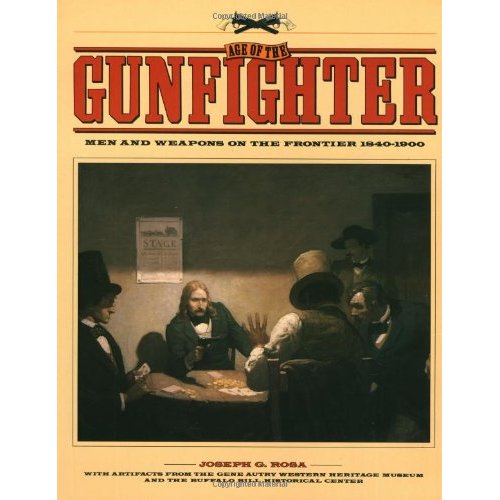Written by: Greg Ellifritz
I’ve written a lot recently about the history of firearms instruction. That topic has only existed for about the last 100 years. Formal weapons training most certainly existed earlier, but it was pre-Civil War and reserved for the luxury class.
Between the end of the US Civil War and the 1920’s there was very little formal firearms training available. People had to learn from a knowledgeable acquaintance or be forced to slowly learn the painful lessons from their own experiences.
That doesn’t mean that there were no competent gunmen in the latter part of the 19th century. In fact, there were massive numbers of gunfighters in the United States.
They had skills but they weren’t graduates of a formal shooting program. Most learned through personal life experience instead. We are all lucky that many of these gunfighters publicized their feats through early books and magazine/newspaper articles. We can learn a lot from those publications.
The nature of gunfighting hasn’t changed much since the advent of cartridge firing pistols. Gunfights today tend to share the same characteristics as gunfights nearly 150 years ago….close ranges, surprise, darkness, moving shooters, and a relatively limited number of shots fired.
The one big difference between today and the days of the old west is the FREQUENCY of gunfights. In a relatively lawless land, people were forced to use their guns much more often than people do now. Today, a police officer in the United States has about a 5% chance of ever having to shoot his gun at another human during his entire career. Most cops will never get into a gunfight. It was rare to find an old west lawman without at least a couple of the proverbial notches in the grips of his revolver.
The experiences of old west lawmen and outlaws have been chronicled by numerous sources, some more accurate than others. When one reads the best of the detailed gunfight accounts, it is not difficult to imagine similar events happening today. Smart folks will draw on the numerous experiences of the old west gunfighters to learn lessons that are valuable even today. The problem that most of us face is trying to separate the true and accurate accounts from the dime-novel accounts that are so prevalent.
I’ve read every old west gunfighting book that I could get my hands on since before I was a teenager. Here is my list of the most accurate and valuable accounts of old west gunfighting history.
Encyclopedia of Western Gunfighters by Bill O’Neal
This book contains short descriptions of all of the historical gunfight records from 255 old west gunfighters. There are a few factual errors, but most of the information is accurate. It is written in the style of an encyclopedia (hence the name) with individual alphabetical entries for every gunfighter imaginable.

The Authentic Wild West: The Gunfighters by James Horan
Long out of print (published in 1976) but still available as a relatively inexpensive used book, it provides accounts from contemporary eyewitnesses of more than 200 gunfights.

Age of the Gunfighter: Men and Weapons on the Frontier, 1840-1900 by Joseph Rosa
This is a great starting book, as the text provides an excellent overview of the old west gunfighters. Where it really shines, however, is in its photographs. This book has the best pictures of guns and gunfighters that has ever been assembled.

The Gunfighters– Time Life Books
As a kid in the 1970s, I was absolutely fascinated with old west history. I remember riding my bike to the library several times a week at an age of about seven years old. This was the book I most commonly read when I when I got there. I recently picked up a copy at a used book store in Nashville and re-read it as an adult. It was amazingly informative and had some of the best photographs I’ve seen anywhere. This one is worthy of a spot on your bookshelf.

Triggernometry: A Gallery of Gunfighters by Eugene Cunningham
Originally published in 1934, this book was one of the first to chronicle the history of the gunfighter. It contains biographies of nearly 20 old west gunmen and an excellent final chapter specifically about weapons and tactics.

I’ve Killed Men: An Epic of Early Arizona by Jack Ganzhorn
This book was written by an early Arizona Ranger way back in 1910. he claims around 40 gunfights and details them all in this book. It’s probably the best book available that details the daily life of an old west gunfighter.
The Gunfighter: Man or Myth? by Joseph Rosa
This book provides brief accounts of dozens of gunfights, but its real strength lies in its attempt to describe the gunfighters’ motivations and mental processes and place them into the proper context given the societal conditions of the time. It also has a couple of good chapters on guns, holsters, and tactics.

Empire of the Summer Moon: Quanah Parker and the Rise and Fall of the Comanches, the Most Powerful Indian Tribe in American History by S.C. Gwynne
Despite the title, much of the book is a history of the Texas Rangers and the early settlement of Central Texas than a biography of Quanah Parker. It provides amazing insight into the everyday life of folks who engaged in gun battles with Indians and criminals on a very regular basis.
There you have it, eight books that will further your combative education. There are lots of lessons to be learned from these accounts. If you believe in the adage: “If you want to find something new, read an old book!”, these are the best “old books” to analyze.
If you would like some more reading ideas, check out my Recommended Reading Page.
* Some of the above links are affiliate links. That means that if you purchase these items, I get a small percentage of the selling price.




Pistol Pete wrote a good book that is worth a read: “Veteran of the Old West: Pistol Pete”
Anon
Be very careful of Eugene Cunningham’s “Triggernometry”. It was the book that John Bianchi mandated I read when I worked for him as gunleather designer 1970-1990 but recent research turns up that Cunningham was a dime novelist. As such he wrote fictionalized accounts of gunfighters on order from newspaper editors (I’ve seen the list!). His most famous abuse of history was his many, many stories about Tom Threepersons of Texas, all of which are probatively FALSE. His stories were spread into modern times by the likes of Charlie Askins and Skeeter Skelton, both of whom who I knew back in their day, who drew on a newspaper clippings scrapbook of which I have a complete copy from a former owner. The current Wiki entry about Tom draws on it and is very, very wrong but I’ve not the patience to correct it thoroughly but he is covered in detail, correctly, in my book “Holstory – Gunleather of the Twentieth Century”.
Thanks, Red. I appreciate you taking the time to comment. I bought your Holstory book on the very first day I learned about it. I really enjoyed the content and commentary you shared.